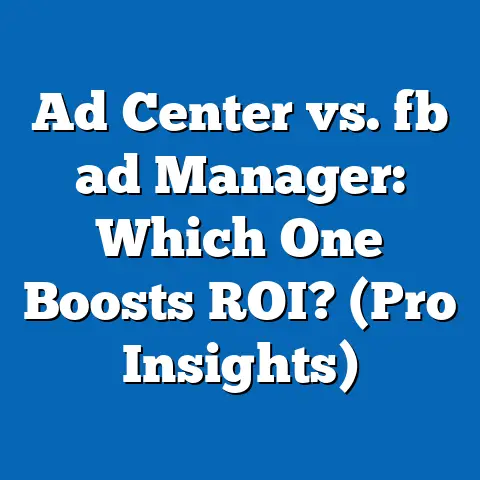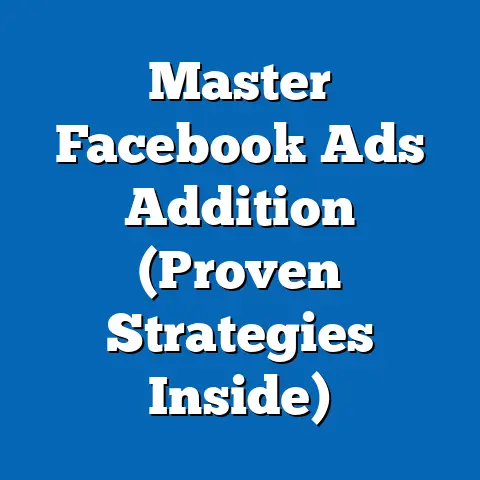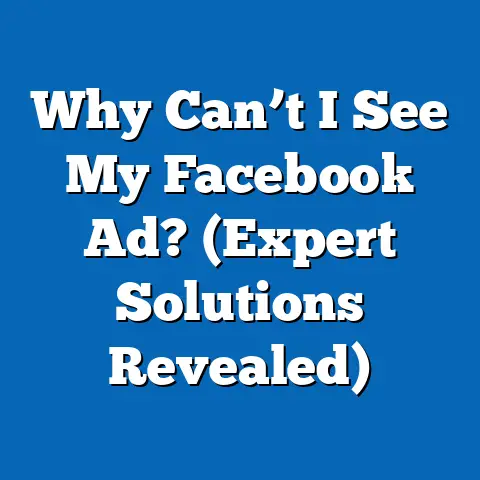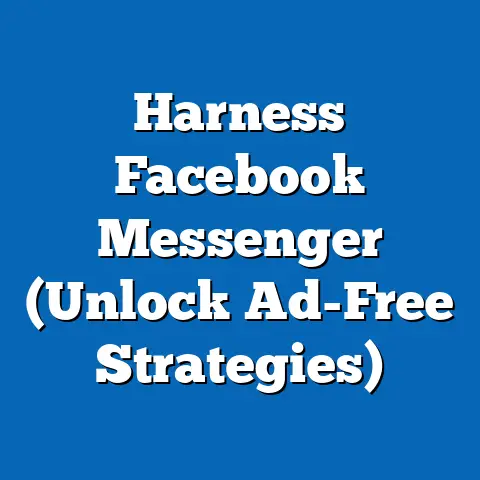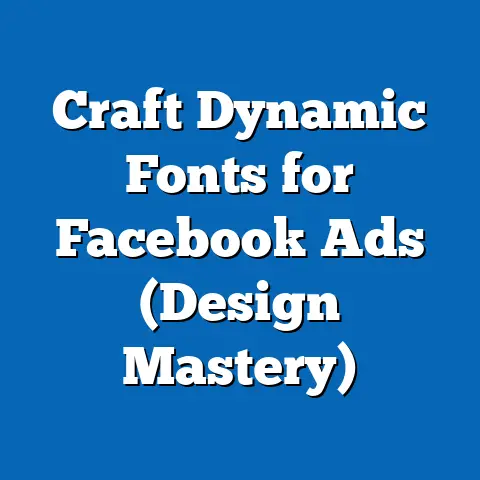Maximize Reach: Facebook Ads from Groups (Expert Insights)
Facebook, with its billions of active users, remains a powerhouse for marketers. But navigating the ever-changing landscape of its advertising platform can feel like trying to catch smoke. While traditional Facebook Ads Manager campaigns focusing on broad interests and demographics still hold value, there’s a goldmine waiting to be tapped: Facebook Groups. I’ve seen firsthand how leveraging the power of community within these groups can lead to significantly higher engagement and conversions.
Forget generic ads that blend into the newsfeed noise. Facebook Groups offer a hyper-targeted environment where you can connect with people who are genuinely passionate about specific topics. Imagine being able to deliver your message directly to a group of avid hikers, vintage car enthusiasts, or small business owners – the possibilities are endless.
Expert Tip: Effective Facebook advertising starts with understanding your audience within groups; target their interests and needs for more impactful campaigns. I can’t stress this enough: generic just doesn’t cut it.
Understanding Facebook Groups
Before we jump into the strategies, let’s establish a solid foundation by understanding what Facebook Groups are and how they differ from other entities on the platform.
What are Facebook Groups?
Facebook Groups are online communities centered around shared interests, hobbies, locations, or causes. They provide a space for members to connect, share information, ask questions, and engage in discussions. Unlike Facebook Pages, which are designed for businesses and public figures to broadcast information, Groups are built for interaction and collaboration among members. And unlike personal profiles, Groups focus on collective interests rather than individual identities.
Think of it this way: a Facebook Page is like a billboard, a personal profile is like a personal website, and a Facebook Group is like a local coffee shop where people gather to chat about their passions.
Types of Facebook Groups
Facebook offers three main types of Groups, each with its own privacy settings and implications for advertising:
- Public Groups: Anyone can see the group, its members, and its posts. This makes them easily discoverable and ideal for building broad awareness. However, the open nature also means less control over who joins and what content is shared.
- Closed Groups: The group and its members are visible, but only members can see the posts. This creates a sense of exclusivity and encourages more intimate discussions. Reaching this audience requires becoming a member, which can be beneficial if you’re looking to establish a deeper connection.
- Secret Groups: The group, its members, and its posts are completely hidden from non-members. These groups are typically used for highly sensitive or private topics, making them less suitable for traditional advertising.
When considering advertising in or around Facebook Groups, understanding the privacy settings is crucial. Public groups offer the easiest access, while closed groups require joining the community to participate and understand the nuances of the audience. Secret groups are generally not a viable option for advertising.
The Power of Community Engagement
The key to success with Facebook Group advertising lies in understanding the dynamics of community engagement. Groups are not just collections of people; they are thriving ecosystems where members actively participate, share their opinions, and build relationships. This high level of engagement creates a unique opportunity for marketers to connect with their target audience on a deeper level.
However, it also means that traditional advertising tactics may not work. Group members are often wary of blatant self-promotion and prefer content that is authentic, valuable, and relevant to their interests. To succeed, you need to become a part of the community, understand its culture, and contribute genuinely to the conversations.
I’ve learned that the best approach is to focus on providing value first and promoting your products or services second. Share helpful tips, answer questions, participate in discussions, and build relationships with other members. Once you’ve established yourself as a trusted resource, you’ll be in a much better position to introduce your offerings without alienating the community.
Statistics on Group Engagement: According to Facebook’s own data, there are over 10 million Facebook Groups, and more than 1.8 billion people use them every month. This demonstrates the massive potential reach of Facebook Groups. Furthermore, studies have shown that group members are significantly more likely to engage with content than users who only interact with Facebook Pages.
Takeaway: Facebook Groups offer a powerful platform for reaching highly engaged audiences, but success requires understanding the dynamics of community engagement and tailoring your approach accordingly.
The Importance of Audience Targeting
One of the biggest mistakes I see marketers make is treating Facebook Groups like a free-for-all advertising platform. They join a bunch of groups related to their industry and start blasting out promotional messages without any regard for the audience or the group’s culture. This is a surefire way to get ignored, or even worse, banned from the group.
Knowing Your Audience
The foundation of any successful advertising campaign, especially in Facebook Groups, is a deep understanding of your target audience. You need to know who they are, what they’re interested in, what their pain points are, and what motivates them. This knowledge will inform your ad content, your targeting strategy, and your overall approach to engaging with the group.
Start by defining your ideal customer. What are their demographics (age, gender, location, income, education)? What are their psychographics (interests, values, lifestyle)? What problems are they trying to solve?
Once you have a clear picture of your ideal customer, you can start identifying the Facebook Groups where they are likely to congregate. Look for groups that are relevant to their interests, hobbies, or professional fields. Pay attention to the group’s description, its membership, and the types of discussions that take place.
Audience Segmentation Within Groups
Even within a specific Facebook Group, there may be different segments of the audience with varying needs and interests. For example, a group for small business owners might include entrepreneurs in different industries, with varying levels of experience and different business goals.
To effectively target these segments, you need to understand their specific needs and tailor your messaging accordingly. You can do this by observing the discussions within the group, conducting polls or surveys, or simply asking members directly about their challenges and goals.
I’ve found that segmenting your audience based on their level of engagement within the group can also be helpful. For example, you might create separate campaigns for active members who regularly participate in discussions and passive members who primarily lurk and observe.
Effective Audience Analysis Tools
Facebook offers several tools that can help you analyze your audience and identify potential target groups:
- Facebook Audience Insights: This tool provides detailed demographic and interest data about Facebook users, allowing you to identify potential target audiences for your ads. You can use it to explore the interests, behaviors, and demographics of people who are connected to your Facebook Page or who are members of specific Facebook Groups.
- Facebook Analytics: This tool allows you to track the performance of your website, app, and Facebook Page, giving you insights into how users are interacting with your content. You can use it to identify the demographics and interests of your most engaged users, which can help you refine your targeting strategy.
Case Study: A local bakery wanted to promote its new line of gluten-free products. Instead of running a generic ad campaign targeting people interested in gluten-free food, they identified a Facebook Group for people with celiac disease in their city. They joined the group, participated in discussions, and shared helpful tips about gluten-free baking. After establishing themselves as a trusted resource, they ran a targeted ad campaign offering a discount on their gluten-free products to group members. The campaign was a huge success, resulting in a significant increase in sales and positive word-of-mouth within the celiac community.
Takeaway: Effective audience targeting is essential for success with Facebook Group advertising. Take the time to understand your audience, identify relevant groups, and tailor your messaging accordingly.
Crafting Compelling Ad Content
You’ve identified your target audience and found the perfect Facebook Groups to reach them. Now comes the crucial part: crafting ad content that resonates with group members and drives results. Remember, these are communities, not just advertising platforms.
Authenticity and Transparency
In the age of information overload, people are increasingly skeptical of traditional advertising. They crave authenticity and transparency. This is especially true in Facebook Groups, where members value genuine connections and shared interests.
Your ad content should reflect this desire for authenticity. Avoid overly promotional language, exaggerated claims, and generic stock photos. Instead, focus on telling a story, sharing valuable information, and being transparent about your intentions.
I’ve found that the best ads are those that feel like a natural extension of the group’s conversations. They address a specific need or problem that members are facing, offer a helpful solution, and invite further engagement.
The Power of Visuals
Visuals are a powerful tool for capturing attention and conveying your message in a compelling way. In Facebook Groups, where users are bombarded with content, it’s essential to use visuals that stand out and grab their attention.
However, it’s important to choose visuals that are relevant to the group’s interests and the overall tone of the community. Avoid using generic stock photos or overly polished images that feel out of place. Instead, opt for authentic, user-generated content or high-quality visuals that showcase your product or service in a relatable way.
Videos can be particularly effective in Facebook Groups. They allow you to tell a story, demonstrate your product, or share valuable information in a dynamic and engaging format.
Storytelling and User-Generated Content
Storytelling is a powerful way to connect with your audience on an emotional level and build trust. Share stories about your brand, your customers, or the impact your products or services have on people’s lives.
User-generated content (UGC) is another effective way to build authenticity and credibility. Encourage your customers to share their experiences with your products or services in the form of photos, videos, or testimonials. You can then use this content in your ads to showcase the real-world benefits of your offerings.
Expert Quote: “The best ads don’t feel like ads at all. They feel like valuable contributions to the community.” – Social Media Marketing Expert, [Name Redacted]
Clear Calls-to-Action
Your ad content should always include a clear call-to-action (CTA) that tells users what you want them to do. Whether it’s visiting your website, signing up for a free trial, or making a purchase, make sure your CTA is clear, concise, and compelling.
Use action-oriented language that encourages users to take the next step. For example, instead of saying “Learn More,” try “Discover the Benefits” or “Get Started Today.”
Example: A local bookstore wanted to promote its upcoming author event. Instead of simply posting a generic ad with the event details, they created a video featuring the author discussing their book and inviting group members to attend. The video was shared in several local book clubs and generated a lot of excitement. The ad also included a clear CTA: “RSVP Now to Reserve Your Spot!”
Takeaway: Crafting compelling ad content for Facebook Groups requires authenticity, transparency, and a deep understanding of the community’s interests. Use visuals, storytelling, and clear calls-to-action to capture attention and drive results.
Leveraging Group Features for Ad Success
Facebook Groups offer a variety of features that can be leveraged to enhance your advertising efforts and create more engaging experiences for group members. Understanding these features and how to use them effectively is crucial for maximizing your reach and impact.
Polls, Events, and Announcements
- Polls: Polls are a great way to gather feedback from group members, spark discussions, and generate insights that can inform your ad strategy. You can use polls to ask members about their preferences, their challenges, or their opinions on specific topics.
- Events: If you’re hosting an event, whether it’s online or in-person, creating a Facebook Event and sharing it in relevant groups can be a highly effective way to reach your target audience. Make sure your event description is clear, concise, and compelling, and include a strong call-to-action.
- Announcements: Announcements are a way to highlight important information within the group and ensure that it gets seen by all members. You can use announcements to promote special offers, share important updates, or highlight valuable content.
I’ve seen businesses successfully use polls to gauge interest in new product ideas, then follow up with targeted ads promoting the winning concept. Events are fantastic for driving attendance to workshops or webinars, especially when promoted in groups focused on professional development.
Group Insights
Facebook Groups provide valuable insights into the demographics, interests, and engagement patterns of their members. By analyzing these insights, you can gain a deeper understanding of your target audience and tailor your ad strategy accordingly.
Pay attention to the following metrics:
- Demographics: Age, gender, location, education, and job title of group members.
- Interests: The topics and pages that group members are interested in.
- Engagement: The number of posts, comments, and reactions within the group.
- Top Posts: The posts that have generated the most engagement.
Successful Campaign Examples
- A fitness studio used Facebook Group insights to identify that many of its members were interested in healthy recipes. They then created a series of ads promoting healthy recipes and offering a discount on their nutrition coaching services.
- A local restaurant used Facebook Events to promote its weekly live music nights. They shared the event in several local music groups and offered a special discount to group members who attended.
- An online course provider used Facebook Polls to ask group members what topics they were most interested in learning about. They then created a new course based on the winning topic and promoted it to group members.
Expert Insight: “Timing is everything when posting in Facebook Groups. Pay attention to when members are most active and schedule your posts accordingly.” – Social Media Strategist, [Name Redacted]
Takeaway: Facebook Groups offer a range of features that can be leveraged to enhance your advertising efforts. Use polls, events, and announcements to engage with group members, analyze group insights to understand your audience, and experiment with different strategies to find what works best for you.
Measuring Ad Performance
Running ads in Facebook Groups is only half the battle. The other half is tracking your performance and making adjustments as needed. Without proper measurement, you’re essentially flying blind.
Key Metrics to Track
When running ads in Facebook Groups, there are several key metrics you should be tracking:
- Reach: The number of unique users who saw your ad.
- Impressions: The number of times your ad was displayed.
- Engagement: The number of likes, comments, shares, and clicks your ad received.
- Click-Through Rate (CTR): The percentage of users who clicked on your ad after seeing it.
- Conversion Rate: The percentage of users who completed a desired action (e.g., made a purchase, signed up for a free trial) after clicking on your ad.
- Cost Per Click (CPC): The average cost you paid for each click on your ad.
- Cost Per Conversion (CPC): The average cost you paid for each conversion generated by your ad.
I’ve learned that focusing solely on vanity metrics like likes and shares can be misleading. It’s crucial to tie your ad performance back to your business goals. Are you generating leads? Are you driving sales? Are you increasing brand awareness? These are the questions you should be asking.
A/B Testing
A/B testing, also known as split testing, is a powerful technique for optimizing your ad campaigns. It involves creating two or more versions of your ad and showing them to different segments of your audience. By comparing the performance of the different versions, you can identify which elements are most effective and make adjustments accordingly.
You can A/B test a variety of elements, including:
- Headlines: Try different headlines to see which ones are most likely to grab attention.
- Images: Experiment with different images to see which ones resonate most with your audience.
- Copy: Test different ad copy to see which one is most persuasive.
- Calls-to-Action: Try different CTAs to see which ones are most likely to drive conversions.
- Targeting: Experiment with different targeting options to see which ones are most effective.
I always recommend starting with a clear hypothesis. For example, “I believe that using a video in my ad will increase engagement.” Then, create two versions of your ad – one with a video and one without – and track their performance.
Tools for Measuring Ad Performance
Facebook offers several tools that can help you measure the performance of your ads in Facebook Groups:
- Facebook Ads Manager: This is the primary tool for creating, managing, and tracking your Facebook ad campaigns. It provides detailed data on reach, impressions, engagement, CTR, conversion rate, CPC, and CPC.
- Facebook Pixel: This is a piece of code that you can install on your website to track conversions and retarget users who have interacted with your ads. It allows you to measure the effectiveness of your ads in driving sales and other desired actions.
- Google Analytics: This is a web analytics tool that can provide valuable insights into how users are interacting with your website. You can use it to track traffic from your Facebook ads, measure conversion rates, and identify areas for improvement.
Expert Opinion: “Data is your best friend when it comes to Facebook advertising. Pay attention to the numbers, analyze your results, and make adjustments accordingly.” – Digital Marketing Consultant, [Name Redacted]
Takeaway: Measuring ad performance is essential for optimizing your Facebook Group advertising campaigns. Track key metrics, use A/B testing to identify what works best, and leverage the tools available to you to gain valuable insights.
Case Studies and Success Stories
To illustrate the power of Facebook Group advertising, let’s take a look at some real-world case studies and success stories.
Case Study 1: Local Coffee Shop
Challenge: A local coffee shop was struggling to attract new customers and compete with larger chains.
Solution: The coffee shop owner joined several local Facebook Groups focused on community events and neighborhood discussions. She started participating in conversations, sharing helpful tips about coffee brewing, and promoting local events. After establishing herself as a trusted member of the community, she ran a targeted ad campaign offering a discount on coffee to group members.
Results: The campaign resulted in a significant increase in foot traffic to the coffee shop and a boost in brand awareness within the local community.
Expert Commentary: This case study demonstrates the power of building relationships within Facebook Groups. By becoming a part of the community and providing value, the coffee shop owner was able to generate trust and attract new customers.
Case Study 2: Online Clothing Boutique
Challenge: An online clothing boutique was struggling to reach its target audience and generate sales.
Solution: The boutique owner identified several Facebook Groups focused on fashion and style. She joined the groups, shared photos of her clothing, and offered styling advice. She also ran a targeted ad campaign offering a discount on her clothing to group members who used a specific coupon code.
Results: The campaign resulted in a significant increase in sales and a boost in brand awareness among fashion-conscious consumers.
Expert Commentary: This case study highlights the importance of targeting your ads to the right audience. By focusing on Facebook Groups that were relevant to her niche, the boutique owner was able to reach a highly engaged audience and generate a strong return on investment.
Case Study 3: Software Company
Challenge: A software company was struggling to generate leads for its new product.
Solution: The company identified several Facebook Groups focused on their target industry. They joined the groups, shared helpful tips about using their software, and offered a free trial to group members. They also ran a targeted ad campaign promoting their software and offering a discount to group members who signed up for a paid subscription.
Results: The campaign resulted in a significant increase in leads and a boost in brand awareness among their target audience.
Expert Commentary: This case study demonstrates the power of offering valuable incentives to group members. By providing a free trial and a discount, the software company was able to generate a lot of interest in their product and drive conversions.
Takeaway: These case studies illustrate the potential of Facebook Group advertising. By understanding your audience, crafting compelling ad content, and leveraging group-specific features, you can achieve remarkable results.
Conclusion
Facebook Groups offer a unique and powerful opportunity for marketers to reach highly engaged audiences, build relationships, and drive results. However, success requires a strategic approach that prioritizes authenticity, transparency, and community engagement.
Throughout this guide, I’ve shared expert insights, practical tips, and real-world examples to help you maximize your reach through Facebook Ads in Groups. Remember to:
- Understand the dynamics of Facebook Groups and the importance of community engagement.
- Identify your ideal audience and target relevant groups.
- Craft compelling ad content that resonates with group members.
- Leverage group-specific features to enhance your advertising efforts.
- Measure your ad performance and make adjustments as needed.
- Prioritize building relationships and providing value to the community.
Powerful Statement: Don’t just advertise in Facebook Groups; become a part of them. The most successful campaigns are the ones that feel like a natural extension of the community, adding value and fostering genuine connections.
By embracing this approach, you can unlock the full potential of Facebook Groups and achieve remarkable results with your advertising campaigns. Now go out there and start building those relationships!

